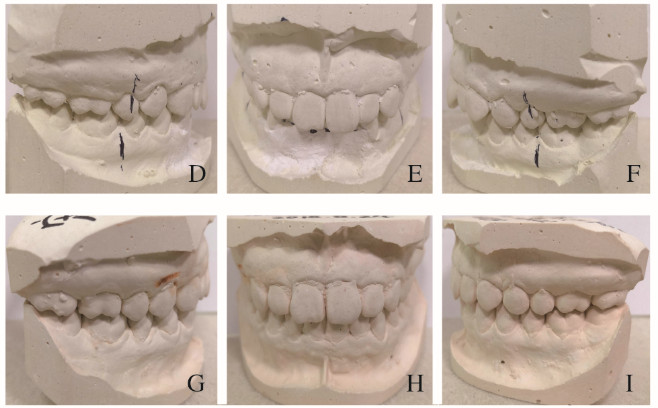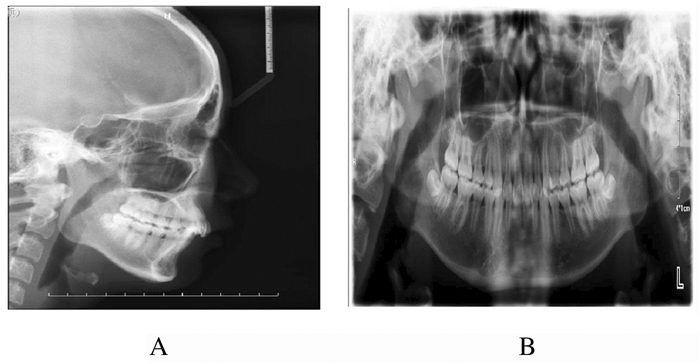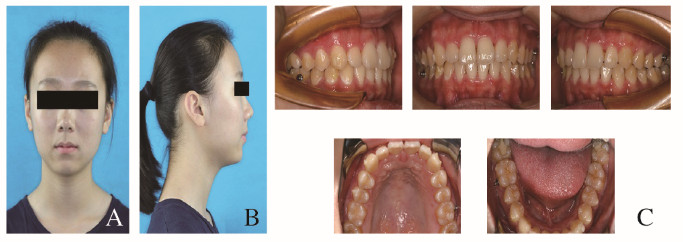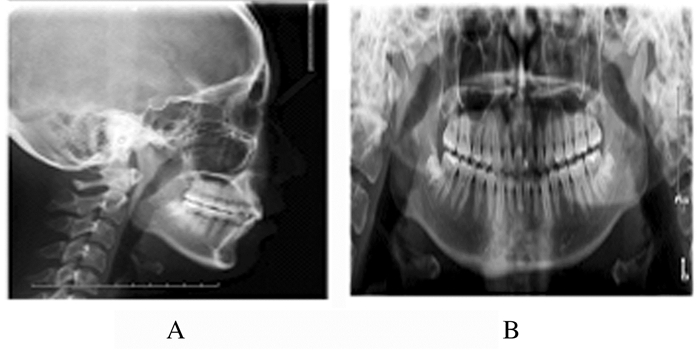扩展功能
文章信息
- 曹阳, 朱宪春, 庄金良, 陈远萍
- CAO Yang, ZHU Xianchun, ZHUANG Jinliang, CHEN Yuanping
- 应用Twin Block和隐适美矫治器对安氏Ⅱ1类患者行双期矫治1例报告及文献复习
- Application of Twin Block appliance and Invisalign appliance as two-phase treatment for Angle class Ⅱ divison 1 malocclusion: Acase report and literature review
- 吉林大学学报(医学版), 2019, 45(06): 1440-1444
- Journal of Jilin University (Medicine Edition), 2019, 45(06): 1440-1444
- 10.13481/j.1671-587x.20190642
-
文章历史
- 收稿日期: 2019-05-05
安氏Ⅱ1类错牙合畸形是临床常见的错牙合类型,即磨牙远中关系且上前牙唇向倾斜,常表现为前牙深覆盖、深覆牙合和开唇露齿等[1]。这种错牙合畸形不仅影响患者正常口腔功能,也阻碍颌骨发育,易出现下颌后缩,影响面型及美观,危害患者的心理健康及社交状况[2]。对于此类错牙合畸形,早期功能性矫治可预防牙外伤[3],并促进颌骨发育[4]和改善面貌,有利于青少年身心健康成长。目前临床上多采用早期功能性矫治以促进颌骨正常发育,二期常规矫治以排齐牙列并精细调整咬合的双期矫治来治疗此类错牙合畸形。功能性矫治阶段常用的矫治器包括Twin Block、FRⅡ、Herbst和Activator等。Twin Block矫治器因具有佩戴舒适,患者配合良好,适应证较多且对下切牙的唇向倾斜较其他功能性矫治器小[5]等优点而广泛应用于临床。在常规矫治阶段,通常选择以直丝弓矫治器为代表的固定矫治器。但患者佩戴固定矫治器时常出现疼痛、损伤口腔黏膜等不适症状,早期矫治阶段因不能保持口腔卫生,易发生龋病和影响牙周健康。而以隐适美矫治器为代表的无托槽隐形矫治器因其美观、舒适和可自行摘戴有利于口腔卫生维护等优点[6]受到了广大患者的青睐。国内外已有相关研究[7-8]显示:Twin Block与直丝弓固定矫治器联合应用可较好地改善安氏Ⅱ1类患者的侧貌,达到良好的治疗效果,但对Twin Block与隐适美矫治器联合应用的治疗效果尚未见报道。本文作者对1例安氏Ⅱ1类患者应用Twin Block和隐适美矫治器行双期矫治,探讨该治疗方案的疗效。
1 临床资料 1.1 一般资料患者,女性,13岁,因“牙齿排列不齐”于2016年1月就诊于吉林大学口腔医院正畸科。面部检查:患者面部左右不对称,颏点右偏,下颌后缩。口内检查:恒牙列,右侧磨牙关系为基本中性关系,左侧磨牙关系为开始远中关系。上颌中线居中,下颌中线右偏约2 mm。前牙覆牙合Ⅲ°、覆盖Ⅰ°。上牙弓Ⅰ°拥挤,下牙弓Ⅱ°拥挤。22、32和42舌腭向错位,11、21、31和41外翻(图 1和2,见插页八)。颞下颌关节未见弹响与疼痛,开口度及开口型均未见明显异常。曲面断层片(图 3)显示38和48近中倾斜阻生。X线头影测量分析:SNA角为80°,SNB角为75.8°,ANB角为4.2°。根据临床检查、模型分析和头颅定位侧位片测量结果,该患者诊断为安氏Ⅱ1类错牙合畸形、毛氏Ⅱ2+Ⅳ1+Ⅰ1类错牙合畸形。

|
| A-C:Before treatment; D-F:After Twin Block treatment; G-1:After Twin Block +Invisalign treatment; A, D, G:Right side view; B, E, H:Front view; C, F, I:Left side view. 图 1 安氏Ⅱ1类错殆畸形患者治疗前后的牙齿模型 Fig. 1 Tooth model of patient diagnosed as Angle class Ⅱ divison 1 malocclusion before and after treatment |
|
|

|
| A:Frotal view; B:Profile view; C:Intraoral view. 图 2 治疗前安氏Ⅱ1类错殆畸形患者面像和口内像 Fig. 2 Extraoral and intraoral photographs of patient diagnosed as Angle class Ⅱ divison 1 malocclusion before treatment |
|
|

|
| A:Lateral radiograph; B:Panoramic radiograph. 图 3 安氏Ⅱ1类错牙合畸形患者治疗前X线片 Fig. 3 X-ray images of patient diagnosed as Angle class Ⅱ divison 1 malocclusion before treatment |
|
|
第一阶段:应用Twin Block功能性矫治器矫治,扩大上颌牙弓后段同时诱导下颌向前发育,改善安氏Ⅱ类骨面型。功能性矫治10个月后,患者面容较矫治前有所改善,颏部前移。口内检查:恒牙列,双侧磨牙关系为开始近中关系,双侧尖牙关系为中性关系,上颌中线居中,下颌中线右偏约2 mm,前牙覆牙合Ⅱ°、覆盖Ⅰ°(图 4,见插页八)。

|
| A:Frotal view; B:Profile view; C:Intraoral view. 图 4 Twin Block矫治器治疗安氏Ⅱ1类错殆畸形患者面像和口内像 Fig. 4 Extraoral and intraoral photographs of patient diagnosed as Angle class Ⅱ divison 1 malocclusion treated with Twin Block appliance |
|
|
第二阶段:功能性矫治结束,开始应用隐适美矫治器行二期矫治,历时20个月。通过伸长上下颌后牙,压低上下颌前牙以改善深覆牙合。通过序列化远中移动左侧磨牙、近中移动右侧磨牙,提供间隙排齐上下颌牙列并调整中线。隐适美矫治器建议每周更换1副,佩戴39副后对个别尚未达到理想状态的牙齿进行精细调整。精细调整阶段佩戴矫治器共16副。此后去除牙面附件,拍摄X线片,结束矫治,进入保持阶段。
1.3 数据整理和分析测量分析X线头颅定位侧位片。测量模型的牙弓前、中和后段宽度及长度。以鼻顶点与软组织颏前点为连线测量软组织侧貌的Ricketts审美平面。
2 结果 2.1 患者颌面和牙牙合表现矫治后患者上下颌牙列排齐整平,前牙覆牙合覆盖正常,中线对正,上下中线一致,双侧尖牙、磨牙均达到中性牙合关系,上下牙弓宽度协调,面部左右基本对称协调(图 5,见插页八)。曲面断层片(图 6)可见:所有牙根平行,未见明显吸收现象,38和48水平低位阻生,建议拔除。

|
| A:Frotal view; B:Profile view; C:Intraoral view. 图 5 治疗后安氏Ⅱ1类错殆畸形患者面像和口内像 Fig. 5 Extraoral and intraoral photographs of patient diagnosed as Angle class Ⅱ divison 1 malocclusion after treatment |
|
|

|
| A:Lateral radiograph; B:Panoramic radiograph. 图 6 安氏Ⅱ1类错牙合畸形患者治疗后X线片 Fig. 6 X-ray images of patient diagnosed as Angle class Ⅱ divison 1 malocclusion after treatment |
|
|
矫治前后X线头颅定位侧位片测量值比较显示:双期矫治结束后,SNB角增大1.7°,ANB角减小0.7°,MP-FH无明显变化;L1/MP角增大8°,U1/L1角减小6°,达到正常值;U1-NA距减小,L1-NB距增大。见表 1。
| Group | SNA(θ/°) | SNB(θ/°) | ANB(θ/°) | U1-NA(l/mm) | U1-NA(θ/°) | L1-NB(l/mm) | L1-NB(θ/°) | U1/L1(θ/°) | U1/SN(θ/°) | L1/MP(θ/°) | MP-FH(θ/°) |
| Normal value | 82.8±4.0 | 80.1±3.9 | 2.7±2.0 | 5.1±2.4 | 22.8±5.7 | 6.7±2.1 | 30.3±5.8 | 125.4±7.9 | 105.7±6.3 | 92.6±7.0 | 31.1±5.6 |
| Before treatment | 80 | 75.8 | 4.2 | 5.15 | 23.0 | 4.22 | 18.0 | 135.0 | 103.2 | 89.0 | 29.0 |
| After Twin Block appliance | 81 | 77.0 | 4.0 | 3.87 | 17.0 | 5.32 | 22.0 | 136.9 | 98.0 | 91.5 | 30.0 |
| After treatment | 81 | 77.5 | 3.5 | 3.88 | 20.5 | 6.80 | 27.0 | 129.0 | 103.0 | 97.0 | 28.8 |
矫治前后模型测量结果显示:功能性矫治后,上下颌牙弓后段宽度明显增加;二期矫治结束后,上下颌牙弓中段宽度明显增加;双期矫治结束后,上颌牙弓宽度增加主要体现在牙弓中段,增加了3.8 mm,而下颌牙弓宽度增加主要体现在牙弓后段,增加了3.4 mm,见表 2。上下颌牙弓长度也有所增加,见表 3。矫治前后软组织测量结果显示:应用Ricketts审美平面分析,矫治后颏部前移。
| (l/mm) | |||||||||||||||||||||||||||||
| Group | Maxillary dental arch width | Mandibular dental arch width | |||||||||||||||||||||||||||
| Anterior | Middle | Posterior | Total | Anterior | Middle | Posterior | Total | ||||||||||||||||||||||
| Before treatment | 36.0 | 37.0 | 47.0 | 120.0 | 25.0 | 31.0 | 42.0 | 98.0 | |||||||||||||||||||||
| After Twin Block appliance | 38.0 | 38.7 | 49.1 | 125.8 | 26.4 | 31.9 | 43.7 | 102.0 | |||||||||||||||||||||
| After treatment | 37.1 | 40.8 | 50.4 | 128.3 | 27.2 | 33.8 | 45.4 | 106.4 | |||||||||||||||||||||
| (l/mm) | |||||||||||||||||||||||||||||
| Group | Maxillary dental arch length | Mandibular dental arch length | |||||||||||||||||||||||||||
| Anterior | Middle | Posterior | Total | Anterior | Middle | Posterior | Total | ||||||||||||||||||||||
| Before treatment | 7.5 | 18.5 | 19.5 | 45.5 | 3 | 7 | 19 | 39 | |||||||||||||||||||||
| After Twin Block appliance | 7.5 | 18.5 | 19.5 | 45.5 | 3 | 7 | 19 | 39 | |||||||||||||||||||||
| After treatment | 8.0 | 18.5 | 20.5 | 47.0 | 6 | 18 | 21 | 43 | |||||||||||||||||||||
该患者为青少年,面部左右不对称,下颌后缩伴轻度拥挤,并存在下颌中线右偏等问题。综合分析该患者情况,判断其可行双期矫治。在功能性矫治阶段,利用Twin Block矫治器诱导其下颌骨向前发育。在二期矫治阶段,考虑到患者面部不对称和中线偏斜问题,利用隐适美矫治器远中移动牙齿的优势[9],在解除拥挤的同时调整中线,改善面部不对称。矫治后头颅定位侧位片测量结果显示:SNB角增大1.7°,ANB角减小0.7°,说明下颌骨向前生长;矫治后面相和口内相显示患者面部基本对称,牙齿排齐整平,上下中线一致,提示通过Twin Block和隐适美矫治器行双期矫治达到了预期目的,取得了良好的矫治效果。此外,Twin Block和隐适美矫治器均由患者自行摘戴,矫治结果能否达到预期与患者依从性有极大关系。研究[10]表明:患者在使用可摘戴型矫治器时,会夸大佩戴时间。因此实行该方案时,应提高患者依从性,严格要求患者佩戴时间,以保障治疗效果。
Twin Block矫治器是一种具有明显促进下颌发育作用的功能性矫治器。长时间地佩戴Twin Block矫治器不仅使咀嚼系统适应下颌前伸位,也促进髁突和关节改建,刺激髁突软骨的生长,从而增加下颌骨长度[11]。此外,该矫治器体积小,佩戴舒适,对咀嚼及发音影响小,更有利于口腔卫生维护,可得到患者的良好配合[12],因此增加了患者的依从性。BACCETTI等[13]认为:在青春期或青春期晚期使用Twin Block矫治器治疗,下颌骨长度和高度的生长量将会增加,并有利于磨牙关系的建立。研究[14]表明:青春期时行Twin Block矫治,其效果与早期矫治并无差异,但可节约时间与治疗成本。AMINIAN等[15]对1例初潮后安氏Ⅱ类患者行Twin Block矫治,矫治后患者下颌明显向前发育,面型得到改善。该患者也在青春期晚期开始佩戴Twin Block功能性矫治器进行矫治,矫治结果与上述病例一致。
无托槽隐形矫治是近些年在口腔正畸临床非常受欢迎的一种新兴矫治技术。无托槽隐性矫治器基于牙颌模型数字化技术、矫治过程中的计算机辅助设计技术等[16],利用弹性压膜材料制作而成,通过持续地小范围移动牙齿可达到矫治目的;其矫治力主要为矫治器与牙齿的位置差异使压膜材料发生变形后产生的回弹力,力的大小和作用时间均可得到有效控制[17]。这一特点有利于缩短矫治时间,患者可更快完成矫治[18]。对于低龄患者,无托槽隐形矫治器有助于其更好地维护口腔卫生,减少对牙周组织产生的不利影响[19]。此外,无托槽隐形矫治器也可减轻患者的疼痛[20],减少由于机械摩擦带来的黏膜损伤[19],使患者更加舒适。对于安氏Ⅱ类伴轻中度拥挤患者,无托槽隐形矫治技术可通过远中移动上颌磨牙并配合Ⅱ类颌间牵引,维持前牙矢状向位置及后牙高度[21]。
隐适美矫治器作为美国Align公司最早推出,于2011年引进中国的一种新型的无托槽隐形矫治器,在牙移动方式上有独特优势。压低是隐适美矫治器效能较高的移动方式[9],尤其在矫治前牙方面更具优势。矫治器在唇舌侧完全包绕牙冠,施加的力可通过前牙阻抗中心,更有利于高角深覆牙合患者的垂直向控制[22]。远中移动亦是隐适美矫治器效能较高的移动方式[9],序列远中移动后牙对安氏Ⅱ类患者矫治的有效性得到了广泛证实[23]。此外,隐适美矫治器利用附件及其辅助工具可在唇舌向倾斜移动及控根移动方面不断调整,取得良好的矫治效果。但由于隐形矫治器在伸长和旋转中的作用效果欠佳[9],正畸医师仍应谨慎选择合适的患者行隐形矫治。
综上所述,对处于生长发育期的安氏Ⅱ1类患者,利用Twin Block矫治器诱导下颌骨向前发育后通过隐适美矫治器进行常规矫治,可以较好地改善侧貌及达到正常牙合,并带给患者良好的矫治体验,得到患者的好评与认可。
| [1] |
傅民魁. 口腔正畸学[M]. 6版. 北京: 人民卫生出版社, 2012: 54.
|
| [2] |
谢冰. 错畸形对青少年口腔健康相关生活质量的影响[J]. 中国医学工程, 2014, 22(10): 117-117. |
| [3] |
THIRUVENKATACHARI B, HARRISON J, WORTHINGTON H, et al. Early orthodontic treatment for Class Ⅱ malocclusion reduces the chance of incisal trauma: Results of a Cochrane systematic review[J]. Am J Orthod Dentofacial Orthop, 2015, 148(1): 47-59. |
| [4] |
周洪. 功能性矫治器治疗生长发育期下颌后缩[J]. 中国实用口腔科杂志, 2009, 2(10): 595-599. |
| [5] |
侯景秋, 闫征斌. Twin Block矫治器矫治安氏Ⅱ类1分类错畸形[J]. 四川生理科学杂志, 2005, 27(1): 16-17. |
| [6] |
NEDWED V, MIETHKE R R. Motivation, acceptance and problems of Invisalign patients[J]. J Orofac Orthop, 2005, 66(2): 162-173. |
| [7] |
汤秀春, 陈振琦, 王永武, 等. 35例安氏Ⅱ类1分类错双期矫正的临床分析[J]. 上海口腔医学, 2012, 21(3): 325-328. |
| [8] |
TSIOULI K, TOPOUZELIS N, PAPADOPOULOS M A, et al. Perceived facial changes of Class Ⅱ Division 1 patients with convex profiles after functional orthopedic treatment followed by fixed orthodontic appliances[J]. Am J Orthod Dentofacial Orthop, 2017, 152(1): 80-91. |
| [9] |
王硕, 孙雨虹, 华先明. Invisalign技术创新及牙移动效能[J]. 口腔疾病防治, 2018, 26(11): 743-748. |
| [10] |
AL-MOGHRABI D, SALAZAR F C, PANDIS N, et al. Compliance with removable orthodontic appliances and adjuncts: A systematic review and meta-analysis[J]. Am J Orthod Dentofacial Orthop, 2017, 152(1): 17-32. |
| [11] |
MILLS J R. The effect of functional appliances on the skeletal pattern[J]. Br J Orthod, 1991, 18(4): 267-275. |
| [12] |
MILLS C M, MCCULLOCH K J. Treatment effects of the twin block appliance: A cephalometric study[J]. Am J Orthod Dentofacial Orthop, 1998, 114(1): 15-24. |
| [13] |
BACCETTI T, FRANCHI L, TOTH L R, et al. Treatment timing for Twin-block therapy[J]. Am J Orthod Dentofacial Orthop, 2000, 118(2): 159-170. |
| [14] |
O'BRIEN K, WRIGHT J, CONBOY F, et al. Early treatment for Class Ⅱ Division 1 malocclusion with the Twin-block appliance: A multi-center, randomized, controlled trial[J]. Am J Orthod Dentofacial Orthop, 2009, 135(5): 573-579. |
| [15] |
AMINIAN A, SARVAREH AZIMZADEH S, RAHMANIAN E. Cl Ⅱ malocclusion treatment, using the modified Twin Block appliance coordinated with fixed orthodontics in a postmenarche patient[J]. Case Rep Dent, 2017, 2017: 2525374. |
| [16] |
白玉兴, 王邦康, 田杰. 无托槽隐形矫治技术的原理及接诊流程[J]. 实用口腔医学杂志, 2008, 24(3): 454-456. |
| [17] |
白玉兴. 无托槽隐形矫治技术发展中的喜与忧[J]. 中华口腔医学杂志, 2017, 52(9): 521. |
| [18] |
GU J, TANG J S, SKULSKI B, et al. Evaluation of Invisalign treatment effectiveness and efficiency compared with conventional fixed appliances using the Peer Assessment Rating index[J]. Am J Orthod Dentofacial Orthop, 2016, 151(2): 259. |
| [19] |
翟明表, 孙艳, 郭剑虹, 等. 无托槽隐形矫治与传统固定矫治在错颌畸形患儿正畸治疗中的对比观察[J]. 河北医科大学学报, 2019, 40(1): 65-69. |
| [20] |
李炎钊, 谭家莉, 郑钰婷, 等. 初戴无托槽隐形矫治器与Damon Q自锁托槽成年女性正畸疼痛对比研究[J]. 中国实用口腔科杂志, 2017, 10(2): 92-94. |
| [21] |
李志芳, 王伟财, 麦理想. 无托槽隐形矫治技术远移磨牙治疗上前牙轻、中度拥挤的效果[J]. 口腔疾病防治, 2018, 26(5): 314-319. |
| [22] |
胡炜, 刘洋, 陈贵. 无托槽隐形矫治深覆的临床初步研究[J]. 中华口腔正畸学杂志, 2017, 24(2): 65-69. |
| [23] |
RAVERA S, CASTROFLORIO T, GARINO F, et al. Maxillary molar distalization with aligners in adult patients: a multicenter retrospective study[J]. Prog Orthod, 2016, 17(1): 12. |
 2019, Vol. 45
2019, Vol. 45


